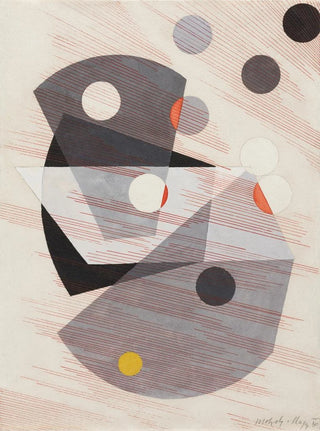Art print | Gray Overlaps - László Moholy-Nagy


View from behind

Frame (optional)
Art print Chevauchements gris - László Moholy-Nagy – Engaging Introduction
The artwork "Chevauchements gris" by László Moholy-Nagy is an invitation to delve into visual experimentation and reflections on perception. This iconic piece, embodying the Bauhaus movement, displays a harmony of shapes and shades, evoking a subtle dance between light and shadow. The artist, through his innovative approach, captures the very essence of the interaction between space and the viewer. Through this art print, the piece presents itself as a mirror of our own perception, encouraging us to reevaluate our environment and our relationship with art.
Style and uniqueness of the work
"Chevauchements gris" stands out for its bold use of geometric forms and monochrome tones. Moholy-Nagy plays with superimpositions, creating effects of depth and movement that challenge traditional painting conventions. The shades of gray, both delicate and powerful, evoke an atmosphere of serenity while inspiring internal dynamism. This work is not just a simple painting; it is an immersive experience that engages the viewer in a visual dialogue. Mastery of composition and precision of lines reveal a rare aesthetic sensitivity, where each element finds its place within a coherent whole. Thus, "Chevauchements gris" transcends the frame of art to become a reflection on modernity and perception.
The artist and his influence
László Moholy-Nagy, an emblematic figure of the Bauhaus, made his mark by his innovative approach to art and design. Born in Hungary, he quickly established himself as a pioneer in exploring new technologies and materials. Moholy-Nagy always sought to build bridges between different artistic disciplines, integrating photography, cinema, and graphic design into his work. His influence extends far beyond his time, inspiring many contemporary artists to explore the limits of art and rethink their relationship with the world around them. Through works like "Chevauchements gris," he reminds us that art is a space for experimentation and

Matte finish

View from behind

Frame (optional)
Art print Chevauchements gris - László Moholy-Nagy – Engaging Introduction
The artwork "Chevauchements gris" by László Moholy-Nagy is an invitation to delve into visual experimentation and reflections on perception. This iconic piece, embodying the Bauhaus movement, displays a harmony of shapes and shades, evoking a subtle dance between light and shadow. The artist, through his innovative approach, captures the very essence of the interaction between space and the viewer. Through this art print, the piece presents itself as a mirror of our own perception, encouraging us to reevaluate our environment and our relationship with art.
Style and uniqueness of the work
"Chevauchements gris" stands out for its bold use of geometric forms and monochrome tones. Moholy-Nagy plays with superimpositions, creating effects of depth and movement that challenge traditional painting conventions. The shades of gray, both delicate and powerful, evoke an atmosphere of serenity while inspiring internal dynamism. This work is not just a simple painting; it is an immersive experience that engages the viewer in a visual dialogue. Mastery of composition and precision of lines reveal a rare aesthetic sensitivity, where each element finds its place within a coherent whole. Thus, "Chevauchements gris" transcends the frame of art to become a reflection on modernity and perception.
The artist and his influence
László Moholy-Nagy, an emblematic figure of the Bauhaus, made his mark by his innovative approach to art and design. Born in Hungary, he quickly established himself as a pioneer in exploring new technologies and materials. Moholy-Nagy always sought to build bridges between different artistic disciplines, integrating photography, cinema, and graphic design into his work. His influence extends far beyond his time, inspiring many contemporary artists to explore the limits of art and rethink their relationship with the world around them. Through works like "Chevauchements gris," he reminds us that art is a space for experimentation and






